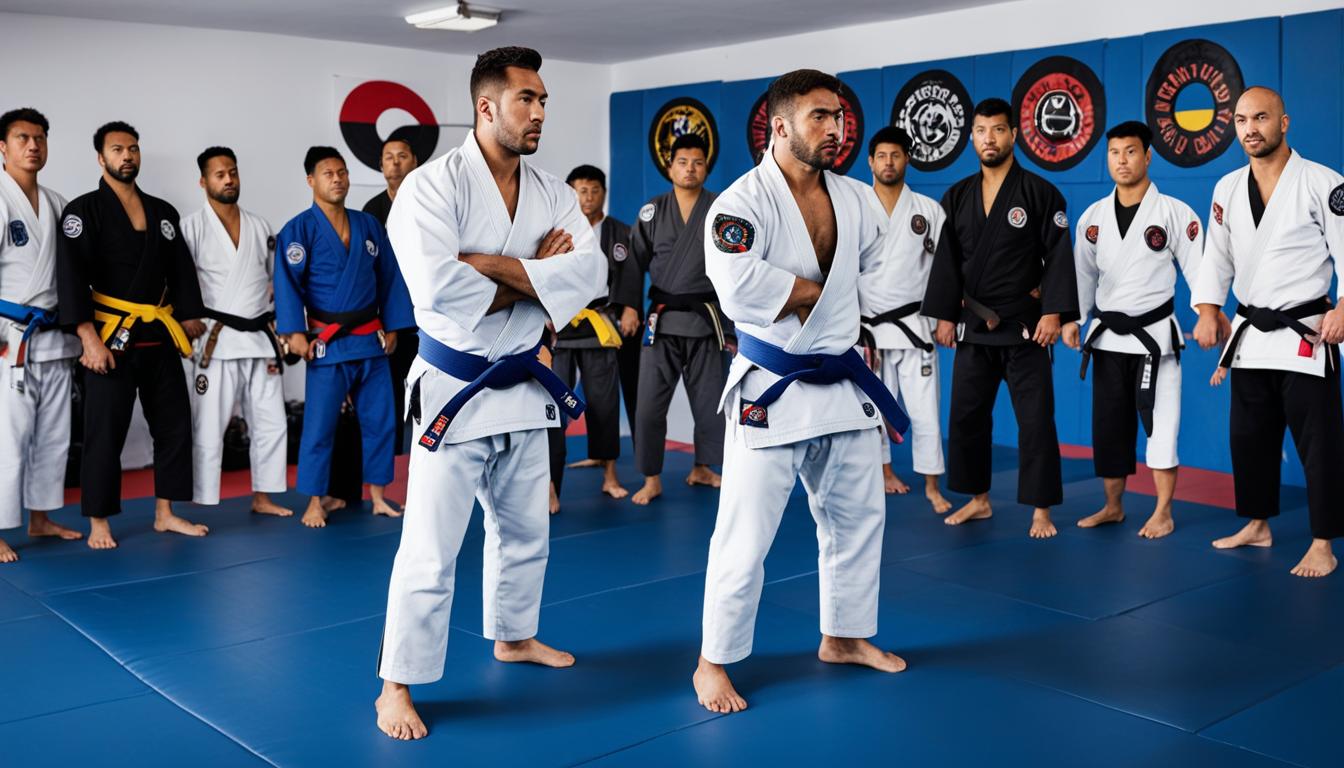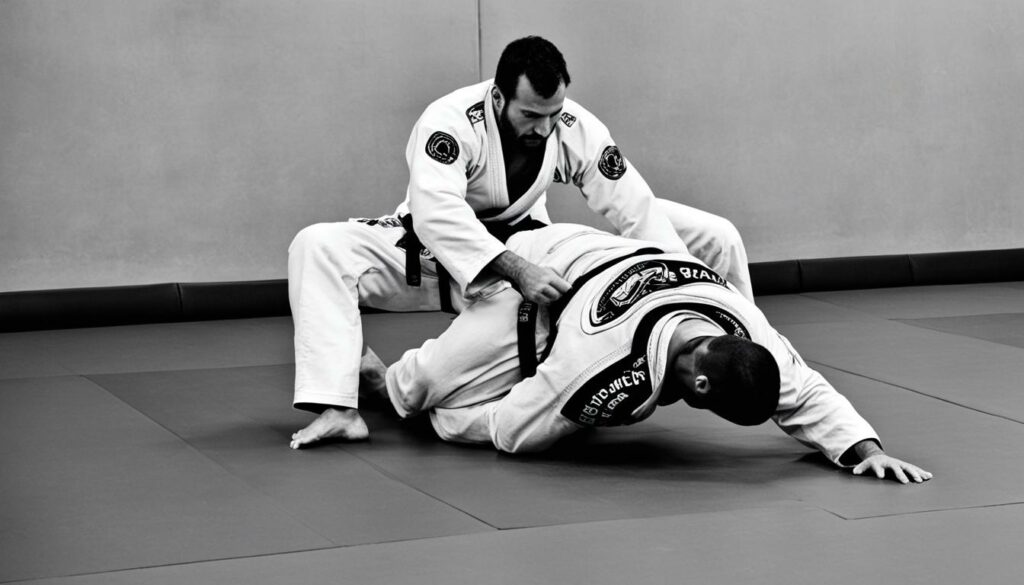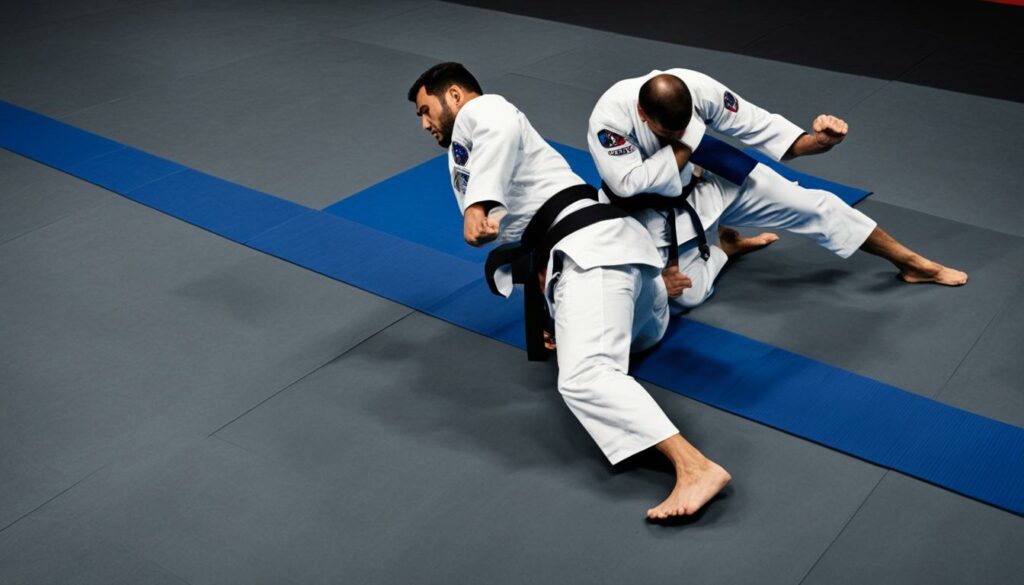When I embarked on my journey in Brazilian Jiu-Jitsu, the question of “how long to get black belt in BJJ” was ever-present in my mind. I quickly realized that the path to a BJJ black belt duration was not just a measure of time, but of personal growth and commitment. On average, the Brazilian Jiu-Jitsu black belt timeframe spans from 7 to 10 years, a testament to the dedication required to reach the summit of this martial art.
Key Takeaways
- Attaining a black belt in BJJ is a profound journey that necessitates long-term dedication.
- The timeframe to achieve this prestigious rank is not set in stone, varying between 7 to 10 years.
- Becoming a BJJ black belt involves mastering a myriad of techniques and developing a personal fighting style.
- The journey is steeped in personal growth, overcoming challenges and potentially dealing with injuries.
- This robust timeframe reflects the depth of knowledge and experience required to be proficient in Brazilian Jiu-Jitsu.
Understanding the BJJ Belt Ranking System
As someone deeply involved in the world of Brazilian Jiu-Jitsu, I can’t overstate the importance of comprehending the BJJ belt progression time and the intricacies of the BJJ ranking system. Now, let’s delve into the hierarchical setup of these belts and what it takes to advance through each stage.
The Hierarchical Structure of BJJ Belts
Starting my BJJ journey, I was immediately introduced to the structured approach of the BJJ belt requirements. This coveted path starts at white and gradually progresses through a series of colors, each symbolizing a new chapter in skill development. Let me outline the stages of BJJ belts and the typical timeline for those aspiring to climb the BJJ ladder.
| Belt Color | Typically Required Time | Notable Skills and Requirements |
|---|---|---|
| White | 1-2 years | Foundations and basic principles |
| Blue | 2-3 years | Development of technical repertoire |
| Purple | 1.5-2 years | Advanced techniques and strategy application |
| Brown | 1-1.5 years | Refinement of personal style |
| Black | Indefinite | Mastery and ability to teach |
The Significance of Belt Colors in Your Progress
In BJJ, a belt is more than a decorative achievement—it’s a map of one’s progress, resilience, and dedication. The transitions from white to blue, then onto purple and beyond, have not just reflected my growing technical proficiency, but have also marked an evolution in my approach to practice and competition.
The Role of Stripes and Promotions
It’s noteworthy that the BJJ promotion timeline isn’t just about jumping from one belt color to the next; stripes play a critical role as well. These markers indicate progression within a belt level and often serve to motivate and signify incremental improvements. Receiving a stripe ignites a surge of pride and pushes me to strive for the next stage in this disciplined martial arts form.
Understanding the complexity and requirements of each BJJ belt and rank has not only driven my physical training but has also invigorated my mental and strategic approach to the sport. Following this time-honored traditions and demanding requirements, the black belt, in the end, represents not just proficiency, but a lifelong dedication to the art of Brazilian Jiu-Jitsu.
Starting Your BJJ Journey: The White Belt Phase
Embarking on the path to achieve a black belt in BJJ is a formidable endeavor that starts with understanding the BJJ white belt fundamentals. It’s the start line where the average time for a BJJ black belt begins to tick away. For me, the white belt phase was about grasping the core principles of Brazilian Jiu-Jitsu—laying the foundation upon which my entire BJJ journey would rest.
The initial lesson in beginning BJJ was quickly learning that, unlike other martial arts, progression is not just about time served, but skills acquired and the ability to apply them effectively. I had to shed the notion of using brute strength and instead focus on technique, leverage, and timing—concepts that, once mastered, would carry me far beyond this initial stage.
As a BJJ white belt, my focus was on mastering the art of survival, learning to defend myself, and recognizing the right moments to escape or submit my opponent. The journey at this level of BJJ is one of personal growth and building blocks for future success.
It’s commonly cited that the time to achieve a black belt in BJJ can consume a decade or more, but those parameters are elastic, influenced by daily commitment, the frequency of training, and the rate of personal development. The metamorphosis from white belt novice to a seasoned practitioner starts to accelerate as knowledge is converted into reflex.
- Learn and repeat basic defenses and escapes
- Understand the roles of balance, weight distribution, and positioning
- Incorporate BJJ principles into muscle memory through drills
- Stay faithful to training schedules to expedite progression
Stripes adorning my white belt were much more than just accolades indicating I was ready for the next challenge; they were markers of the time invested and milestones that kept me motivated. Every stripe earned was proof of my evolving understanding of BJJ, a testament to personal development over the days, weeks, and months of rigorous training.
The journey towards becoming a black belt is a rich narrative, each chapter denoted by the color of a belt, starting with white. As I look ahead from the beginning of this quest, I’m cognizant that the road is long, but with dedication, the average time for a BJJ black belt will not just mark the culmination of a time period but the beginning of a lifetime’s practice and philosophy.
Grasping the Fundamentals: Transition from White to Blue Belt
The journey from a white to blue belt in BJJ is not just marked by physical prowess but more so by the understanding and mastering of BJJ fundamentals. For me, as for many, the transition embodied a significant achievement that beckons the appreciation for the art of Brazilian Jiu-Jitsu. Curiosity might have led me to the mat, but it was the challenge of this transition that made the commitment real. Let’s dive deeper into what this crucial milestone entails.
Assessing the Average Time for This Major Milestone
While the Brazilian Jiu-Jitsu black belt duration may stretch far into the horizon, navigating from white to blue can usually be forecasted within a one to two-year range. This estimation, however, is highly subjective; dedication and training habits vary considerably among practitioners. I remember being on the mats and observing that each journey was intimately personal, woven with unique patterns of progress and plateaus.
Key Factors Affecting Your Progress at White Belt
My progress at the white belt level was touched by several factors, a concoction of frequency, intensity, attentiveness, and even philosophical alignment with coaches. Here’s a bit of what I learned:
- Consistency in training was paramount. As I showed up, so did my skills.
- The quality of instruction and feedback could elevate the learning curve exponentially.
- Engagement with fellow students, sharing struggles and victories alike, fostered a deeper understanding of techniques.
Strategies for Accelerating Your Blue Belt Promotion
Acknowledging these elements, one might strategize to expedite their white to blue belt promotion in BJJ. Here are some elements one might consider incorporating:
- Setting clear training goals and reviewing them regularly helped keep me on track.
- Participating in seminars and workshops provided fresh perspectives and techniques.
- Recording sparring sessions and analyzing them post-training allowed for self-critique outside of class hours.
It is important to underscore that the rush to blue should never overshadow the necessity of truly mastering the basics. After all, a belt is only as good as the skills and knowledge it genuinely represents. Keep that in mind as you patiently, yet fervently, weave your path from white to the symbolic blue.
Intermediate Challenges: The Blue to Purple Belt Journey
My time as a blue belt in Brazilian Jiu-Jitsu was characterized by significant growth, perseverance, and the inevitable frustration synonymous with grappling’s intermediate plateau – a journey known for its testing duration of approximately 3 to 6 years. This phase of the BJJ belt promotion timeline saw me putting to test every ounce of knowledge and skill cultivated from the white belt trenches. The blue belt not only offered a broader canvas to refine my techniques but was also instrumental in building my resilience, both mental and physical, which is a rite of passage en route to the purple belt.
Within the realms of blue to purple belt in BJJ, I navigated through riding peaks of success and troughs of stagnation – the so-called “blue belt blues.” It’s in this nuanced dance of progress and plateaus that I discovered the true depth of BJJ. As my skill set expanded, so did the challenges—every roll with my peers turned into a subtle game of chess, with each move and countermove shaping the strategies that define my personal BJJ style. This reflective period was rooted in analysis and refinement rather than the acquisition of troves of new techniques.
The BJJ intermediate challenges extended beyond the mat; adhering to IBJJF’s standards meant being patient and unwavering in dedication. It wasn’t merely about tallying the hours and days spent grappling but immersing myself in the profound complexities of the art, allowing time, practice, and experience to guide me towards readiness for the next milestone. From technical prowess to emotional intelligence, the transitional path from blue to purple belt sculpted a more complete, adaptive, and versatile practitioner ready to dive deeper into the vast ocean of Brazilian Jiu-Jitsu.



